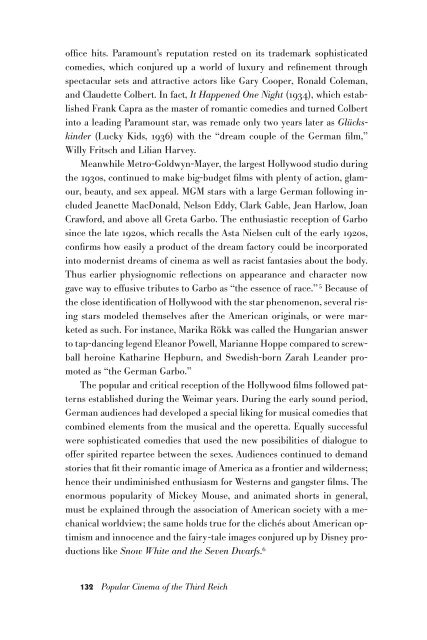Create successful ePaper yourself
Turn your PDF publications into a flip-book with our unique Google optimized e-Paper software.
office hits. Paramount’s reputation rested on its trademark sophisticated<br />
comedies, which conjured up a world of luxury and refinement through<br />
spectacular sets and attractive actors like Gary Cooper, Ronald Coleman,<br />
and Claudette Colbert. In fact, It Happened One Night (1934), which established<br />
Frank Capra as the master of romantic comedies and turned Colbert<br />
into a leading Paramount star, was remade only two years later as Glückskinder<br />
(Lucky Kids, 1936) with the “dream couple of the German film,”<br />
Willy Fritsch and Lilian Harvey.<br />
Meanwhile Metro-Goldwyn-Mayer, the largest Hollywood studio during<br />
the 1930s, continued to make big-budget films with plenty of action, glamour,<br />
beauty, and sex appeal. MGM stars with a large German following included<br />
Jeanette MacDonald, Nelson Eddy, Clark Gable, Jean Harlow, Joan<br />
Crawford, and above all Greta Garbo. The enthusiastic reception of Garbo<br />
since the late 1920s, which recalls the Asta Nielsen cult of the early 1920s,<br />
confirms how easily a product of the dream factory could be incorporated<br />
into modernist dreams of cinema as well as racist fantasies about the body.<br />
Thus earlier physiognomic reflections on appearance and character now<br />
gave way to effusive tributes to Garbo as “the essence of race.” 5 Because of<br />
the close identification of Hollywood with the star phenomenon, several rising<br />
stars modeled themselves after the American originals, or were marketed<br />
as such. For instance, Marika Rökk was called the Hungarian answer<br />
to tap-dancing legend Eleanor Powell, Marianne Hoppe compared to screwball<br />
heroine Katharine Hepburn, and Swedish-born Zarah Leander promoted<br />
as “the German Garbo.”<br />
The popular and critical reception of the Hollywood films followed patterns<br />
established during the Weimar years. During the early sound period,<br />
German audiences had developed a special liking for musical comedies that<br />
combined elements from the musical and the operetta. Equally successful<br />
were sophisticated comedies that used the new possibilities of dialogue to<br />
offer spirited repartee between the sexes. Audiences continued to demand<br />
stories that fit their romantic image of America as a frontier and wilderness;<br />
hence their undiminished enthusiasm for Westerns and gangster films. The<br />
enormous popularity of Mickey Mouse, and animated shorts in general,<br />
must be explained through the association of American society with a mechanical<br />
worldview; the same holds true for the clichés about American optimism<br />
and innocence and the fairy-tale images conjured up by Disney productions<br />
like Snow White and the Seven Dwarfs. 6<br />
132 Popular Cinema of the Third Reich

















